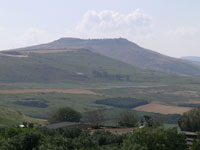The land of Israel frequently reveals hidden treasures testifying to its rich history. This time, an ancient Egyptian amulet was found in the Galilee.
During an excursion with his small children in the Horns of Hattin National Park in the Lower Galilee on Tuesday, Amit Haklai, a local resident, picked up a tiny white object that caught his eye from among the black basalt stones.
Amit noticed that the object was carved in the shape of a beetle and had designs engraved on it, and he immediately recognized that it is an ancient seal. He quickly called the Israel Antiquities Authority (IAA) and turned the seal over to them. In return, he only asked to know what was engraved on the seal, and what can be learned about the site from it.
The seal was identified by Dr. Daphna Ben-Tor, curator of ancient Egyptian culture at the Israel Museum, as a scarab, that is an amulet, from the time of the New Kingdom in Egypt.
“The scarab portrays the pharaoh Thutmose III seated on a throne and in front of him is a cartouche – an oval enclosing symbols that represent his name written in hieroglyphics,” Ben-Tor explained.
“Thutmose ruled for many years throughout the fifteenth century BCE, and during his reign Egypt established a series of administrative-governmental centers in Canaan. It was here that he conducted numerous military campaigns, the most famous of which was the Battle of Megiddo in the Jezreel Valley – a victory that is commemorated in the enormous reliefs on the walls of the Karnak temple in Egypt,’ she explained.
“Scarabs”, says Dr. Ben-Tor, “were carved in the shape of a dung beetle – a creature of cosmological significance in ancient Egypt. Numerous scarabs have been found in archaeological excavations in Israel, and together with other artifacts of Egyptian origin, they are a testimony to the cultural, economic and political influence of Egypt in Canaan in the Late Bronze Age.”

Horns of Hattin. (IAA)
The Horns of Hattin is an extinct volcano with two peaks that resemble horns, hence the name. The site is located on the Gospel Trail, a modular walking trail from Nazareth to Capernaum that follows the trail Jesus may have walked.
The site is famous because of the Battle of Hattin, which was waged there in 1187 between Saladin, ruler of the Ayyubid dynasty of Damascus, and the armies of the Christian Franks whom he defeated and thus brought to an end the first Crusader kingdom. Many years prior to this, in the Late Bronze Age, a citadel stood on the mountain that was probably destroyed in the thirteenth century CE.
“Even though the scarab was found on the surface rather than in an archaeological excavation, it seems to be associated with the period when the citadel existed,” IAA archaeologist Yardena Alexandre said.
By: United with Israel Staff

Free Ebook: 10 Best Places to Visit in Israel
The Land of Israel has provided the backdrop for some of the most important events in human history. From the Old City in Jerusalem to the Sea of Galilee, people from all over the globe visit the Holy Land each year to take in the breathtaking scenery and inspiration of Israel. Now you can experience this beauty for yourself from the comforts of home and maybe plan a trip of your own to Israel. Get the free, exclusive eBook from United with Israel: The 10 Best Places to Visit in Israel.
Do You Love Israel? Make a Donation - Show Your Support!
Donate to vital charities that help protect Israeli citizens and inspire millions around the world to support Israel too!
Now more than ever, Israel needs your help to fight and win the war -- including on the battlefield of public opinion.
Antisemitism, anti-Israel bias and boycotts are out of control. Israel's enemies are inciting terror and violence against innocent Israelis and Jews around the world. Help us fight back!






















